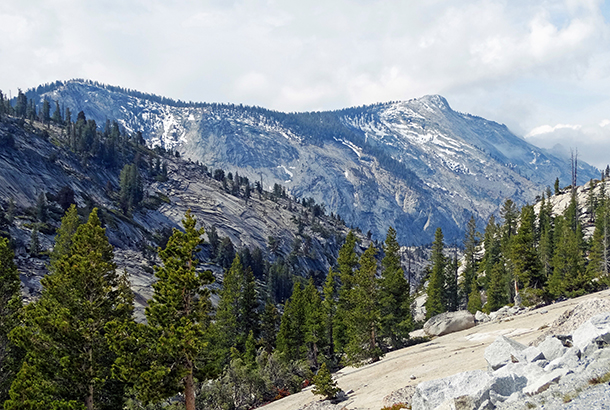Science Note: The Power of Dust
Air Date: Week of May 19, 2017

Ecosystems with intense erosion, like the Sierra Nevada mountains, can benefit greatly from the minerals in airborne dust. (Photo: Don Graham, Flickr CC BY-SA 2.0)
In the Sierra Nevada mountains, heavy runoff and erosion can steal precious soil nutrients from the ecosystem. New research shows replacements come from an unlikely source: dust flying in from far away, as Noble Ingram explains on this week’s Note on Emerging Science.
Transcript
CURWOOD: It’s Living on Earth. I’m Steve Curwood. In a minute, a handy guide to the mysteries of the universe, but first this note on emerging science from Noble Ingram.
[SCIENCE NOTE THEME]
INGRAM: If you’re looking to do some spring cleaning, it can be a big nuisance. But ask any gardener, and you may be surprised to hear that dust is good for more than just collecting in odd corners. A research team from several Western and Midwestern universities has shown that rock dust plays a critical role in feeding the soil of the Sierra Nevada mountains.
Older mountain ranges, like the Sierra Nevadas, experience heavy rainfall and intense erosion, costing them significant soil nutrients in runoff. In California, dust rich in plant-boosting elements like phosphorous, offers the perfect refreshment to these weathered environments.
Air currents collect the nutrient-dense cargo from deserts and dry valleys and carry it vast distances. Researchers found that between 18% and 45% of deposits in the Sierra Nevadas came from Asia, crossing the Pacific Ocean. Some dust was even detected from the Gobi Desert on the border of China and Mongolia, more than 6,000 miles away.
Despite its beneficial effects, this mineral mobility leaves some scientists worried. Bounties of imported nutrients may help a forest thrive, but they can wreak havoc on surrounding rivers and lakes. Dust-fed algae blooms suck up oxygen and threaten to suffocate fish and crustaceans.
With drought spreading as climate change advances, geologists suspect dustier forecasts are ahead. And cleaning up the potential ecological upsets in their wake will require more than a feather duster.
That’s this week’s note on emerging science. I’m Noble Ingram.
Links
EurekAlert! press release: “Dust contributes valuable nutrients to Sierra Nevada forest ecosystems”
Living on Earth wants to hear from you!
Living on Earth
62 Calef Highway, Suite 212
Lee, NH 03861
Telephone: 617-287-4121
E-mail: comments@loe.org
Newsletter [Click here]
Donate to Living on Earth!
Living on Earth is an independent media program and relies entirely on contributions from listeners and institutions supporting public service. Please donate now to preserve an independent environmental voice.
NewsletterLiving on Earth offers a weekly delivery of the show's rundown to your mailbox. Sign up for our newsletter today!
 Sailors For The Sea: Be the change you want to sea.
Sailors For The Sea: Be the change you want to sea.
 The Grantham Foundation for the Protection of the Environment: Committed to protecting and improving the health of the global environment.
The Grantham Foundation for the Protection of the Environment: Committed to protecting and improving the health of the global environment.
 Contribute to Living on Earth and receive, as our gift to you, an archival print of one of Mark Seth Lender's extraordinary wildlife photographs. Follow the link to see Mark's current collection of photographs.
Contribute to Living on Earth and receive, as our gift to you, an archival print of one of Mark Seth Lender's extraordinary wildlife photographs. Follow the link to see Mark's current collection of photographs.
 Buy a signed copy of Mark Seth Lender's book Smeagull the Seagull & support Living on Earth
Buy a signed copy of Mark Seth Lender's book Smeagull the Seagull & support Living on Earth

